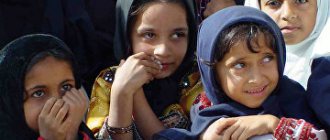The population of Japan, as of October 2021, numbers more than 127 million people, which is 1.67% of the total population of the planet. The average age of the Japanese is 46 years, while the number of residents who celebrated their 90th anniversary in 2021 exceeded 2 million. Okinawa, one of the southern islands of the Japanese archipelago, has an informal name - “land of the immortals,” and all because here There are several hundred people over 100 years old.
World population (as of 2018)
Life expectancy in Japan
Today, the life expectancy ratio in Japan is the highest in the world. The average life expectancy of Japanese people is 83.6 years. Japan remains ahead of other countries not only in terms of the overall indicator, but also in terms of gender. The average age of Japanese women is 86 years, and for men 81 years. Long life expectancy for women is not uncommon around the globe, however, in Japan this difference is not as significant as in other countries.
But Japan hasn't always had such high life expectancy rates. After World War II, the life expectancy in the country hardly exceeded 50 years. The state was fragmented and plundered by the war. People were demoralized, and this could not but affect the level and life expectancy in the state. Therefore, noting this point, it cannot be argued that the longevity of the inhabitants of Japan is a genetic factor.
What is the secret of the island nation's longevity?
After World War II, life expectancy in Japan was the lowest in the world. Knowing today's statistics, it becomes clear that it is not a matter of genes, but something else that makes the Japanese the longest-living nation in the world (and one of the healthiest).
Supply system
The Japanese eat quite varied, and their weekly diet includes up to 100 types of food. Their diet is balanced and consists mainly of fish dishes, seafood, grains, vegetables and tofu cheese. The Western style of eating is very different from what the Japanese eat, and scientists today associate this with the increase in diseases of various organs and systems among residents of America and Europe.
The approach to nutrition also reflects the number of obese patients in the country. In Japan they make up only 3.5% of the total local population. For comparison, in other countries these figures are much higher.
Medicine
Of course, healthy eating is not the only secret to Japanese longevity. The healthcare system in this country is considered the best in the world, providing its citizens with the assistance of highly qualified personnel, the latest medical equipment and partial coverage of treatment costs by the state. The Japanese authorities pay up to 70% of the cost of medical services, and for low-income citizens - up to 90%. Medical expenses are an important indicator of the authorities’ concern for the health of their citizens. Life expectancy increases with an increase in gross domestic product (GDP) and health care spending, and, conversely, the lower a country's GDP, the less money is allocated to medicine, and the shorter its citizens live. However, in Japan, a country with one of the strongest economies in the world, health costs account for 9.5% of GDP. This is quite a bit for a developed country, considering that the average age of its residents is above 40 years. But these indicators are easily explained: the lifestyle of the population, an effective healthcare system and the government’s policy aimed at saving its citizens.
Healthcare costs in selected countries of the world, % of GDP (as of 2021)
Cleanliness
The Japanese are rightfully considered the cleanest nation in the world. Sometimes their desire for cleanliness borders on obsession. Without a doubt, cleanliness leads to health and a reduction in the spread of infectious diseases. In Japan, daily showering and frequent hand washing are the norm, which is not the case in other countries.
Movement
Compared to residents of other countries, the Japanese move a lot. A large number of employees get to work on foot, by bicycle or by train. Cars are an element of luxury here, and in fact, it is much easier to travel by train, because... The railway and subway system in Japan is one of the best in the world. Pensioners also spend their time actively, walking a lot and doing gymnastics. They have much more energy than older Europeans and North Americans.
Older Japanese people move a lot
Family and socialization
In Japan, the eldest child must take care of his parents when they retire. They live together, and as long as they have enough strength, the elderly parents help with the housework. Over time, this approach has changed, but there are still families who follow this tradition and help their elderly relatives. The Japanese believe that living in the same house with children and grandchildren has a positive effect on the psyche of the older generation, awakening in them joy and interest in life. Again, helping around the house is impossible without movement. This allows retirees to maintain minimal physical activity. Even lonely old people in this country try to take care of themselves for as long as possible.
Traditionally, after the end of the working day, Japanese employees gather in bars and cafes for informal communication, and employers in this country welcome this behavior. After retirement, the Japanese do not sit at home, but closely communicate with friends, visit clubs of interest, and practice dancing and singing.
Communication means a lot in the lives of retired Japanese people.
After retirement, the Japanese continue to study, and those who did not receive an education at one time can successfully catch up. Constant training of memory, attention and other thought processes has a positive effect on the general intellectual state of centenarians.
Parenting
Children in Japan are raised in an environment focused on long and active lives. From early childhood, they develop the habit of eating right and taking care of their own hygiene. 98% of schoolchildren, like adults, get to their place of study on foot or by bicycle.
Schoolchildren get to their place of study on foot
High quality of life
Japan has a very developed infrastructure. It is convenient and comfortable to live in this country. Salaries here are high, products are environmentally friendly. It is not customary in the country to be unemployed. The Japanese are ready to commit suicide just to avoid being left without work. This is a great shame for them. Therefore, the country has the lowest unemployment rate on the planet. The economic development of the country is steadily growing upward, gaining momentum every year. Japan is third in the world in terms of GDP. But a high level of quality of life does not mean a high life expectancy. Let's move on to the next points.
Fish, soy, algae
The Japanese practically do not eat red meat and rarely consume dairy products. The basis of the diet is fish. Japan has become famous throughout the world for its sushi and sashimi. But for a simple dinner, a Japanese would rather choose baked mackerel, tuna or salmon.
But soy is consumed in all forms. Every refrigerator has tofu cheese, miso paste, edamame (soybeans). Instead of regular milk, the Japanese use soy milk, and replace salt with fermented sauce.
Soy became fashionable all over the world in the early 2000s. Then her popularity abruptly waned. Soy has been criticized for genetic modification and is considered a dangerous food. However, the Japanese eat a lot of soy and do not notice any problems. And soy contains a lot of vegetable protein and no harmful animal fats.
-Doctor, my body doesn’t have enough iron! -Chew the scissors!
Seaweed is also a wonderful product. Dried seaweed has no calories but is rich in vitamins and minerals. Nori is used not only in sushi, but also as a side dish and added to soups. Light and nutritious foods do not provoke the accumulation of “bad” cholesterol and help avoid the development of heart disease and strokes.
Of course, switching completely to the Japanese diet is difficult. And, perhaps, expensive - after all, most Russians do not live in the coastal zone and seafood is expensive. But it’s definitely worth adding these products to your diet. At least partially replacing meat products with fish and soy will definitely be beneficial.
Health care system
It follows that in addition to a developed economy, another important aspect influences life expectancy - medicine. And among the Japanese there are many world-famous doctors. Medicine and health in this country are treated with special attention. Doctor's orders are followed more strictly than laws in many countries.
The most modern and innovative equipment is installed in the local medical institutions. The Japanese are meticulous about health prevention procedures, so advances in Japanese medicine make it possible to identify serious illnesses at an early stage, when the patient can be cured.
Thanks to all this, the Japanese managed to increase the age of life in the country by many years.
Countries with the lowest life expectancy
As for the countries with the lowest life expectancy, the number of years lived by their population is at the level of 54-60 years. These are mainly African countries with a low level of development of medical technologies, healthcare and amenities, practically deprived of social support from the state. These countries include:
- CAR - 54.36
- Chad - 55.17
- Lesotho - 55.65
- Nigeria - 55.75
- Sierra Leone - 55.92
- Somalia - 58.34
- South Sudan - 58.74
- Ivory Coast - 58.75
- Guinea-Bissau - 59.38
- Equatorial Guinea - 59.82
Diet and Japanese cuisine
This is a very important factor as it holds the lion's share of the secret to life expectancy in Japan today.
The Japanese follow a special diet. And in vain many people think that the Japanese eat only spicy rolls and famous sushi. Japanese cuisine is rich and varied with a variety of dishes. Let's look at the main ones:
Fish and seafood
When it comes to fish, the Japanese prefer tuna and salmon. But you can also see sea bream and the famous puffer fish on the Japanese table.
Other seafood includes: octopus, seaweed, mussels, shrimp, sea urchins and various types of crabs.
Since ancient times, the Japanese have eaten seafood. After all, this is an island state.
Rice
An indispensable product on the table of any Japanese. In every family, in every home, with every meal you will be served rice. In Japan it is called "gohan". The Japanese know dozens of ways to cook rice and serve it in a special way. This food item is symbolic and historical for the people.
Meat
The Japanese eat mainly beef and pork. Yes, exactly pork, despite the fact that it is the fattest and most harmful meat. However, on the long-lived island of Okinawa, people eat exclusively pork. But they also prepare it in a special way, leaving nothing of the carcass. The islanders evaporate all the fat from the meat and only then stew the vegetables on it.
Vegetables
As for vegetables, the Japanese eat everything that they grow on their territory: carrots, sweet potatoes, asparagus, beans, cucumbers, bamboo. And don’t be surprised, bamboo can also be eaten if cooked correctly.
Soybeans
This is a special attribute of any table in Japan, just like rice. The Japanese like to make miso, natto, and soy sauce from soybeans.
Hard noodles
The Japanese prepare ramen (wheat flour and eggs) and udon from noodles. Rice noodles are made from rice flour, and glass noodles are made from beans.
Features of Japanese cuisine
In Japan they like to feel the true taste of food, so they do not overuse spices and seasonings like in neighboring Asian countries. The Japanese try not to fry food, but to eat it raw.
Also, table decoration and etiquette are given a special place. Japan has its own cult of eating food. They eat with chopsticks and in small portions according to a specific order in which dishes are served on the table.
Why don't people use forks in Japan? This is a historical moment. The thing is that chopsticks appeared in those parts long before metal cutlery. Initially, the Japanese ate with their hands and used chopsticks when preparing food. But here another point plays a role - you can’t grab much with chopsticks. Therefore, the Japanese adhere to the principle of “less, but more often,” which allows the digestive system to better cope with stress.
Gerontologists have revealed the secret of Japanese longevity
The truth, as always, is in the details. These “details” of a long life were discussed last year in Moscow by Russian and Japanese experts at a joint conference entitled “Living to be a hundred years old: the secrets of Japanese longevity.”
So, details. Russia is especially interested in them; just look at the statistics.
HELP "MK"
The proportion of older people in both Japan and Russia has been growing in recent years. According to official data, in 2021, average life expectancy in our country reached another historical maximum and amounted to 73.6 years (women - 78.5 years, men - 68.5 years). In Japan, on average, women live 86 years, men - 80 years. As we can see, our women are “falling short” of Japanese women for almost 8 years, and men are falling short of their Japanese counterparts for more than 11 years. And in terms of the number of centenarians, our country is still lagging behind: as of January 1, 2021, 20,582 people in Russia have passed the centenary mark, in Japan - 61,000 people. We have three times less! And in general, older people in Japan make up more than 25%, in Russia - 14% of the total.
“Food for the elderly should be in the form of jelly”
As you know, Japan ranks first in the world in terms of active longevity. This is perhaps the main distinguishing feature of elderly Japanese - their active period of life lasts up to 70 years (for men) and up to 73 years (for women). What does this mean? And the fact that in this country they try not to “turn off” older people from life, and the elderly citizens themselves do not isolate themselves within four walls after retirement.
Moreover, in Japan they do this thoroughly. First, they conducted a large-scale study in which a person’s material wealth was assessed in comparison with the number of years he had lived, as well as the number of his illnesses, Kenji TOBA, chief executive officer of the center for training and innovation at the National Center for Geriatrics and Gerontology of Japan, said at the conference. And they found out that one of the main reasons for low life expectancy in some countries is poverty. And they confirmed this by the example of their country. The poorer a Japanese person was, the shorter his life and the more illnesses he had.
Today in Japan, people live long and enjoy old age, the expert concluded.
The second reason for short life is poor nutrition in old age. According to the director of the same National Center for Geriatrics and Gerontology of Japan, Hidetoshi Endo, an old person should not eat like a young person. And he referred to the experience of America, where they spend several times more on treating the elderly than in Japan, but Americans live less and get sick more. And all because in the States they eat incorrectly: older people eat the same food as young people. In Japan, this is unimaginable: food for the elderly is on special shelves in the store, like food for babies.
“Elderly people have eating disorders,” added Shushudo Takashi, head of the food industry department of the Japanese Ministry of Agriculture, speaking at the conference. “And to make eating easier, older Japanese people give up solid food.
“All food products for people of this age should be in the form of jelly,” say Japanese scientists. In their opinion, today the main product of Japanese elderly people is fish (most often salmon).
And they do not welcome meat in old age; they practically do not eat it, considering it even harmful. It is believed that the Americans taught the Japanese to eat meat. Now in Japan they are fighting this bad habit with all their might.
In the Land of the Rising Sun, they are seriously fighting a tough fight against salt consumption at the national level. And this struggle was crowned with success. If not so long ago the Japanese ate 30–40 grams of salt per day, now, “thanks to propaganda,” this dose has been reduced to 10 grams. “In Russia they think like this: I will eat what I like,” Professor Endo emphasized. “The Japanese don’t do that.”
When it comes to nutrition, the Japanese have another problem - their penchant for hot rice. According to statistics, every second Japanese dies from cancer, and the lion's share of cancers is stomach cancer. And this is also being fought at the state level in Japan.
The oldest person on the planet is Japanese Kane Tanaka, 117 years old.
“Don’t exclude older people from your life”
The third thing that Japanese gerontologists pay attention to is constant study at any age. And devote at least an hour a day to reading. They believe that “brain stagnation” is the cause of many diseases, including Alzheimer’s and dementia. But elderly Japanese spend no more than half an hour a day watching television. For comparison: in Russia, older people sit in front of television screens for at least 5 hours a day, and in the United States, an elderly American spends on average at least 4 hours a day in front of a blue screen.
These figures were confirmed by Elen Mkhitaryan, head of the laboratory of neurogeriatrics and cognitive impairments of the Russian Gerontological Research and Clinical Center, speaking at the conference.
The fourth factor in longevity is movement. As for older Japanese people, they walk outside for at least an hour every day. But older Russians spend 20 times more time watching TV than on physical activity, said Elen Mkhitaryan. According to her, “the problem of our elderly people is that they not only move little, but also rarely eat salmon (they can’t afford it). But many are often forced to deny themselves meat. And as a result of a deficiency of complete protein in the body, muscle loss increases. And one more nuance: as you age you need to drink no less fluid than in your youth, but for some reason older Russians don’t do this and drink less water. Although the need for fluid does not decrease with age.
The fifth factor of a long life is meeting friends. Japanese retirees consider communication with peers to be a prerequisite for a prosperous and enjoyable life. They go with friends to theaters, exhibitions, cafes, and have get-togethers at home.
It must be said that in all this, the elderly in Japan are supported by the state. For this purpose, many different national programs have been created. Even the organization of such a “private” area as caring for bedridden and infirm patients is taken over by the state. A state system of long-term care for elderly people at home has been created. At the same time, the emphasis is on medical and social care in the elderly person’s home environment. And this allows a significant portion of the heaviest burden to be removed from the family and its working members and transferred to the shoulders of social workers.
Also in Japan, government programs aimed at extending active longevity have long been implemented. Much attention is paid to prevention, early detection and effective treatment of chronic diseases, prevention and treatment of dementia. By the way, in Japan, 15% of older people suffer from this disease. And every five years the number of people with dementia doubles.
And in general, the Japanese state takes upon itself the solution of many tasks and problems of demographic aging. Government programs are being implemented to combat hypertension, diabetes, cancer, and dementia. “The main goal of healthy longevity programs is to reduce the gap between total life expectancy and its active period,” it was stated at the conference. Simply put, so that a person not only lives long, but lives his entire life actively and even in old age participates to the best of his ability in the life of the country, while not forgetting about himself.
“What do you want - age!”
In Russia there are also geriatricians and gerontologists. Although, perhaps, someone does not understand the difference in these concepts. In principle, there is not much difference: a geriatrician is a specialist who provides medical care to elderly and elderly people; A gerontologist treats and develops preventive measures for patients over 60 years of age. But in Russia it is somehow not customary to address either one or the other. Probably because they simply don’t exist in primary care. And then - age! In our country, older people need to sit at home and quietly wait for their end. Although our society is also rapidly aging, Russians have begun to live much longer, so our doctors will have to change their attitude towards this category of patients. But for now, even an ambulance may not be sent to a patient if they hear that he is, for example, 80 or over 80. The best thing you can hear from doctors is: “What do you want - age!”
Many people understand the absurdity of this answer. “It is impossible to treat patients “with a discount on age” and allow discrimination on this basis,” says expert Helen Mkhitaryan. “We need to move away from the established opinion that an elderly person does not need to be treated. Especially dementia. Old age and dementia are not synonymous.” To successfully combat neurodegenerative diseases, prevention and early diagnosis play a leading role. According to WHO, Russia is in 6th place in the world in terms of the prevalence of dementia. This is largely due to the late diagnosis of this pathology: even doctors perceive the symptoms as age-related disorders and do not refer patients to specialized specialists who can slow down the development of the disease.
Of course, our elders are largely to blame themselves. Perhaps they lack the Japanese pedantry to clearly follow the basic physical, nutritional and other rules required by age. But the state must also change its attitude towards the elderly. The demographic aging of Russia poses serious challenges for the state. Perhaps, taking into account the experience of our eastern neighbors, it is time to create conditions in the country so that retired Russians do not feel thrown out of life. They could, to the best of their ability, participate in free care for frail old people, freeing young people from this burden for active professional work and caring for their children.
But when can this become a practice? Hard to say. In any case, the chief freelance geriatrician of the Russian Ministry of Health, director of the Russian Gerontological Research and Clinical Center of the Russian National Research Medical University named after. N.I. Pirogov, Professor Olga TKACHEVA was not encouraging. “Geriatricians are appearing in clinics, with whom anyone over 65 can make an appointment. The task of a geriatrician is not to cure a single disease, but to solve a complex of problems of old age associated with the aging process in order to improve the quality of life and preserve a person’s ability to self-care.”
The emphasis, as we see, is on self-service.
...So why do the Japanese live longer than Russians by an average of 10 years? Let's name the main components.
KEY FACTORS FOR LONGEVITY:
active involvement of older people in professional, public and social life, it is necessary to give the brain intellectual stress (read at least an hour a day); this allows you to preserve the cognitive abilities of the brain;
physical activity is required (walk outside for an hour a day), this also affects the prevention of dementia;
eat non-solid foods (jelly-like, like for babies),
minimum salt (no more than 5 g per day);
drink the same amount of water as when you were young;
communicate regularly with family and friends.
As you can see, almost nothing new. It's all about the attitude towards these basic truths not only of the people themselves, but also of the state. The Earth's population is aging; by 2050, older people will make up 22% of the planet's total population. Demographic aging will become one of the significant factors determining the economic, social, cultural and labor agenda of humanity in the near future.
There is nowhere to retreat.
Sports and healthy lifestyle
And the final factor is the nation’s desire for a healthy lifestyle and sports. From early childhood, children engage in various sports, martial arts and simply devote time to physical activity. No one is subject to an age limit in playing sports. It is not uncommon to see an elderly Japanese man who will give odds to any member of the younger generation. Even in old age, the Japanese devote time to physical exercise (to the best of their ability).
The government supports the desire of young (and not so young) people to engage in any type of sports activity. Self-government bodies organize free training in specialized institutions, preferential admission to various sections.
Finding your Ikigai
Ikigai is the Japanese understanding of the meaning of life. It has been proven that people who have clear goals live longer. Every Japanese strives to find himself in four areas:
· what you are really good at doing;
· what they can pay for;
· what you really like to do;
· what the world needs.
If you discard the mystical meaning and leave only the practical, the advice is really good. They help you organize your life, be at peace with yourself and others, and reduce the level of neurosis.
Ideally, a lifelong pursuit should meet all four criteria. But there is nothing wrong with developing each area separately.
Remember how many people quickly faded away after retirement (or after children and grandchildren moved to another country). To avoid putting yourself at risk of premature death, it is important to find motivation to live every day. The Ikigai philosophy will help you move in the right direction.
Japanese attitude towards nature and the environment
In Japan, they take care not only of their health, but also of the health of nature and the environment. The Japanese use the most advanced technologies for recycling and cleaning hazardous waste in production. The country has introduced a large duty on automobile emissions into the atmosphere.
Taken together, these factors add up to the overall picture of the longevity of the Japanese. And it is clear from it that there is nothing magical here. The reason is people’s attitude to work, health, and nutrition. Developed infrastructure and medicine. Respect for the country's resources and ecology. This is why life expectancy is so high in Japan. But all these are factors that influence the life expectancy of any person, regardless of where he lives. Everything is in our hands, and even more so our health.
The main reasons for the high life expectancy of the Japanese population
When studying what explains the high life expectancy of the Japanese population, psychologists and doctors point to a combination of factors. Let's take a closer look at them.
High level of medical care
Japanese people are very attentive to health and medicine. Since 1972, the country has had a law on compulsory medical examination.
Any disease is diagnosed at an early stage. Accordingly, its treatment begins without delay, which minimizes the likelihood of complications. At the same time, the Japanese do not self-medicate, but follow all the doctor’s recommendations.
Japanese medicine is focused on combating the main diseases of older people: stroke, cancer, diabetes. According to Hidetoshi Endo, director of the National Center for Geriatrics and Gerontology of Japan, doctors are promoting, with some success:
- limiting the consumption of salt and sugar, thereby reducing the number of strokes;
- avoiding too hot food, which can cause stomach cancer;
- to give up smoking;
- the need for the diet of older people to increase the amount of protein and calcium.
Compliance with the principles of healthy eating
Healthy eating is one of the key points in the context of the question of why life expectancy is high in Japan. The basis of the diet of local residents: rice, meat, vegetables, fruits, soybeans.
The Japanese menu also includes seafood - octopus, squid, scallops, shrimp, mussels. Favorite types of fish: cod, mackerel, tuna, trout.
According to statistics, one Japanese person eats approximately 68 kg of fish throughout the year, while citizens of other countries consume this product 3 times less.
As for animal meat, in this case the picture is the opposite. One resident of the Land of the Rising Sun eats an average of 45 kg of it per year. For comparison, in France this figure fluctuates around 120 kg, and in the USA – 130 kg.
Interestingly, on the island of long-livers - Okinawa - dishes are prepared mainly from pork, rather than beef. But using a special technology: first, the fat is evaporated from the meat, and then various vegetables are stewed with it.
The Japanese love tea very much. Moreover, they prefer green. Even catering establishments serve it for free. Being a powerful antioxidant, green tea helps fight aging in the body.
An important role in the longevity of Japanese residents is played by their commitment to a healthy and active lifestyle.
Positive outlook on the world
It is unlikely that you will be able to find a country that treats the environment as carefully as Japan. There is even a school subject - “Admiring Nature”, in which walks and excursions are practiced.
The Japanese love to observe natural phenomena. For example, there are 120 synonyms for the word rain in Japanese. Despite the fact that technological progress is developing at an accelerated pace in the Land of the Rising Sun, representatives of the indigenous population value life in harmony with nature.
Active socialization
Caring for elderly family members is an important Japanese tradition. Family members from several generations often live in the same house. Daily communication with children and grandchildren is a good psychological stimulus for older people. Those who for some reason do not have a family are looking for other places to communicate. In Japan, “retirement” clubs and sports clubs are common. Older people communicate, do useful things and even support each other financially.
It has been proven that lonely older people are more likely to suffer from chronic diseases and cognitive impairment. In Russia, there are also circles for the elderly; the main thing is to be active and not be shy to take part in the holidays, which are often organized by volunteers.











